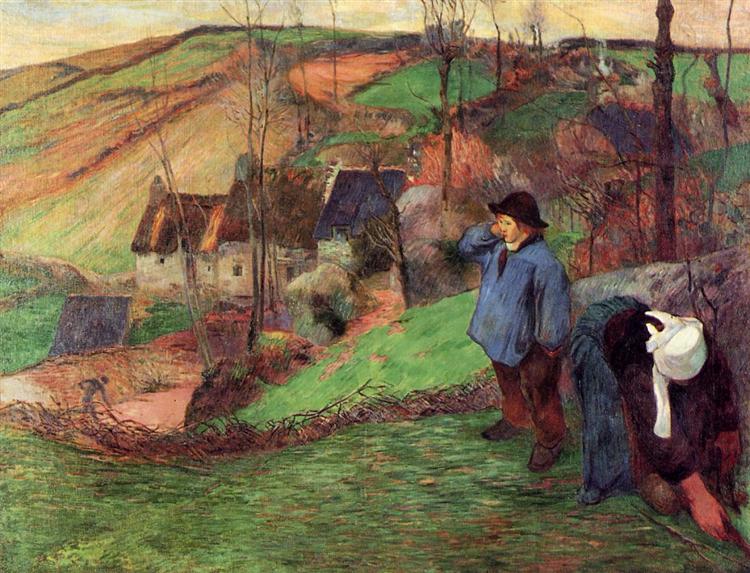Beschrijving
Het werk * Landschap van Groot -Brittannië * (1888) van Paul Gauguin staat als een levendige getuigenis van de evolutie van impressionisme naar symboliek, die de diepe verbinding van de kunstenaar met de Franse landschappen toont, met name de regio van Bretagne, die wist hoe de aandacht te trekken van vele post -impressionisten. In dit schilderij biedt Gauguin ons een boeiend beeld van het Breton -veld, maar transformeert het ook in een esthetische ervaring die verder gaat dan eenvoudige weergave.
Vanuit een compositieperspectief toont het werk een structuur die de verschillende elementen van de scène lijkt in evenwicht te brengen. Het schilderij, hoewel onderworpen aan de regels van perspectief, ontvouwt zich met een vereenvoudiging die veel van de werken van Gauguin kenmerkt. De bomen en heuvels worden gearticuleerd door brede en vloeiende vormen die de ontberingen van strikt naturalisme van de vorige impressionistische beweging tarten. Platte kleurengebieden worden uiteengezet door contouren, die de twee -dimensionaliteit van het werk accentueren en het een bijna decoratieve lucht geeft.
Het gebruik van kleur in * landschap van Brittany * is bijzonder opmerkelijk. Gauguin past een rijk en gedurfd palet toe dat weggaat van de objectieve weergave van natuurlijk licht. De tinten groen van de bomen, het blauw van de lucht en het geel van het veld zijn te vinden in een levendige dialoog, waardoor een sfeer ontstaat die een gevoel van kalmte en melancholie oproept. De helderheid van kleuren wordt niet alleen een manifestatie van licht, maar dient ook om de emotionele toestand uit te drukken dat het wilde communiceren. Door deze chromatische keuze bereikt het een balans die resoneert met symbolistische esthetiek, waarbij het toneel van een bijna dromerige dimensie wordt gedragen.
Hoewel prominente menselijke figuren niet in dit werk worden gepresenteerd, is de aanwezigheid van de mens impliciet in de relatie met het landschap. Deze benadering van de natuurlijke omgeving zonder de directe interferentie van karakters kan worden geïnterpreteerd als een toespeling op het plattelandsleven en de wegen van het bestaan van de Bretons, terwijl het de zoektocht naar Gauguin weerspiegelt om de essentie van de plaats vast te leggen. Dit landschap wordt dan een echo van het menselijk leven dat zich erin ontvouwt, wat een intrinsieke verbinding tussen de mens en zijn omgeving suggereert.
Gauguin maakte * landschap van Brittany * tijdens een van zijn verblijf in de regio, waar hij zich aangetrokken voelde tot zijn lokale gewoonten en zijn ritme van het leven onderscheidde van het bruisende Parijs. Deze periode van zijn leven betekende een artistieke herdefinitie, waarbij zijn interesse buiten de dagelijkse objecten lag die hun aandacht op voorgaande jaren hadden gericht. Bovendien is het interessant om op te merken dat zijn ervaring in Bretagne verweven was met de folklore en spiritualiteit van de regio, kwesties die aanwezig zouden zijn in zijn daaropvolgende werk.
De specifieke stijl van Gauguin in * Landschap van Brittany * is ook symbolisch voor de overgang naar meer gedurfde en persoonlijke technieken die eindelijk zouden culmineren in hun werken in Polynesië, waar de zoektocht naar de primitieve en het authentiek centraal thema zou worden. Het werk is een duidelijke voorloper van de gevoeligheid die Gauguin later zou vertonen, wat een verlangen naar representatie zou uiten die verder gaat dan alleen visualiteit.
Samenvattend is * landschap van Bretagne * veel meer dan een weergave van de natuurlijke omgeving; Het is een getuigenis van de artistieke zoekopdracht van een man die te midden van zijn tijd de essentie van een plaats en cultuur in al zijn complexiteit wilde veroveren. Door de vorm, kleur en een subtiele benadering van figuratie, biedt Gauguin een venster aan zijn innerlijke wereld en de landschappen die hem inspireerden, waardoor de dialoog tussen de mens en het natuurlijke dat hij heeft geresoneerd in kunst in het hele verhaal.
KUADROS ©, een beroemde verf op je muur.
Handgemaakte olieverfschilderijen, met de kwaliteit van professionele kunstenaars en de onderscheidende afdichting van KUADROS ©.
Foto's Reproductieservice met tevredenheidsgarantie. Als u niet helemaal tevreden bent met de replica van uw schilderij, betalen wij uw geld 100%terug.

